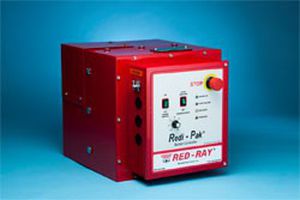
- Industrial machines and equipment
- Heat Exchanger and Refrigeration
- Radiant burner
- SELAS HEAT TECHNOLOGY LLC
Radiant burner F gasdirect firedheating
Add to favorites
Compare this product
Characteristics
- Type
- radiant
- Power source
- gas
- Firing
- direct fired
- Applications
- heating
- Other characteristics
- modular, infrared
- Power
4,000 BTU/h
Description
Used in a wide range of industrial applications such as battery manufacturing, pre-drying, paint flow coating, resin curing, and roofing.
The F series is also used in a wide range of industrial applications such as battery manufacturing, predryers, paint flow coaters, resin curing, roofing materials, etc. Its available in 12” and 7” sizes to allow customer-specified burner assembly lengths for optimum product coverage.
This type of burner employs an air-gas mixture impinging directly on the finned refractory surface to produce a high-density flux of maximum radiance. The flame itself is not the source of infrared radiation. Its function is to heat the refractory to temperatures of 1650° to 2000°F. The refractory then emits infrared energy in the micron range most efficient for the product heating process.
Performance
Develops Radiant Temperatures to 2000°F with Turndown Ratio of 4 to 1
Features and Benefits
Finned cordierite ceramic refractory emitters
Input fuel is converted to 30% infrared, 70% convective energy
Stainless steel spacer (slit orifice) to deliver an even air/gas mixture
High temperature, corrosion resistant alloy side plates
Machined cast iron body
Modular burner sections with carbon steel orifice union connectors
Replaceable ceramic refractory emitters
Radiant heat is distributed uniformly
High velocity radiant heat diffuses surfaces boundary layers on product process
No ported holes to clog
Longer wear resistance no dark areas on refractories
Less warping, increased burner longevity
Structural integrity in continuously operating ovens
Catalogs
Related Searches
- Gas burner
- Direct fired burner
- Natural gas burner
- Nozzle mix burner
- Indirectly fired burner
- Heaters burner
- Fuel oil burner
- Standard burner
- Pilot burner
- Furnace burner
- Infrared burner
- Radiant burner
- Modular burner
- Food burner
- Premix burner
- Hot air burner
- Atmospheric burner
- Flange burner
- Chamber burner
- Air heating burner
*Prices are pre-tax. They exclude delivery charges and customs duties and do not include additional charges for installation or activation options. Prices are indicative only and may vary by country, with changes to the cost of raw materials and exchange rates.















